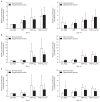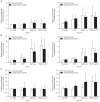Comparative Analysis of Platelet-rich Plasma Effect on Tenocytes from Normal Human Rotator Cuff Tendon and Human Rotator Cuff Tendon with Degenerative Tears
- PMID: 33330145
- PMCID: PMC7726368
- DOI: 10.5397/cise.2018.21.1.3
Comparative Analysis of Platelet-rich Plasma Effect on Tenocytes from Normal Human Rotator Cuff Tendon and Human Rotator Cuff Tendon with Degenerative Tears
Abstract
Background: Platelet-rich plasma (PRP) stimulates cell proliferation and enhances matrix gene expression and synthesis. However, there have been no comparative study of the PRP effect on the normal and degenerative tenocytes. The purpose of this study was to compare the effect of PRP on tenocytes from normal and degenerative tendon.
Methods: Tendon tissues were obtained from patients undergoing arthroscopic repair (n=9) and from healthy donors (n=3). Tenocytes were cultured with 10% (vol/vol) platelet-poor plasma, PRP activated with calcium, and PRP activated with calcium and thrombin. The total cell number was assessed at days 7 and 14. The expressions of type I and III collagen, decorin, tenascin-C, and scleraxis were evaluated by quantitative real-time reverse transcriptase polymerase chain reaction. The total collagen and glycosaminoglycan (GAG) synthesis was evaluated at days 7 and 14.
Results: No differences were observed between the groups at day 7, but cell proliferation was remarkably increased in tenocytes from the degenerative tendon at day 14. In both tenocyte groups, the gene expressions of type I and III collagen were up-regulated. GAG synthesis was greater in the normal tendon, whereas the expressions of decorin and tenascin-C were increased in tenocytes from the degenerative tendon. Tenocytes from the degenerative tendon had higher fold-change of GAG synthesis and a lower collagen III/I ratio than normal tenocytes.
Conclusions: PRP promoted the cell proliferation and enhanced the synthesis of tendon matrix in both groups. PRP has a greater positive effect on cell proliferation, matrix gene expression and synthesis in tenocytes from degenerative tendon.
Keywords: Platelet-rich plasma; Rotator cuff; Tendon; Tenocytes.
Copyright © 2018 Korean Shoulder and Elbow Society.
Conflict of interest statement
Conflict of interest None.
Figures







Similar articles
-
Platelet-rich plasma stimulates cell proliferation and enhances matrix gene expression and synthesis in tenocytes from human rotator cuff tendons with degenerative tears.Am J Sports Med. 2012 May;40(5):1035-45. doi: 10.1177/0363546512437525. Epub 2012 Feb 23. Am J Sports Med. 2012. PMID: 22366517
-
Effects of Platelet-Rich Plasma With Concomitant Use of a Corticosteroid on Tenocytes From Degenerative Rotator Cuff Tears in Interleukin 1β-Induced Tendinopathic Conditions.Am J Sports Med. 2017 Apr;45(5):1141-1150. doi: 10.1177/0363546516681294. Epub 2017 Jan 6. Am J Sports Med. 2017. PMID: 28061032
-
The effect of autologous platelet rich plasma on tenocytes of the human rotator cuff.BMC Musculoskelet Disord. 2018 Nov 30;19(1):422. doi: 10.1186/s12891-018-2339-5. BMC Musculoskelet Disord. 2018. PMID: 30497435 Free PMC article.
-
Efficacy of platelet-rich plasma in arthroscopic repair of full-thickness rotator cuff tears: a meta-analysis.J Shoulder Elbow Surg. 2015 Dec;24(12):1852-9. doi: 10.1016/j.jse.2015.07.035. Epub 2015 Oct 9. J Shoulder Elbow Surg. 2015. PMID: 26456434 Review.
-
Is platelet-rich plasma an ideal biomaterial for arthroscopic rotator cuff repair? A systematic review and meta-analysis of randomized controlled trials.J Orthop Surg Res. 2019 Jun 20;14(1):183. doi: 10.1186/s13018-019-1207-9. J Orthop Surg Res. 2019. PMID: 31221198 Free PMC article.
Cited by
-
Will Platelet Rich Plasma Open New Era for Treatment of Rotator Cuff Tear?Clin Shoulder Elb. 2018 Mar 1;21(1):1-2. doi: 10.5397/cise.2018.21.1.1. eCollection 2018 Mar. Clin Shoulder Elb. 2018. PMID: 33330144 Free PMC article. No abstract available.
-
Characterization of Tendon-Specific Markers in Various Human Tissues, Tenocytes and Mesenchymal Stem Cells.Tissue Eng Regen Med. 2019 Mar 4;16(2):151-159. doi: 10.1007/s13770-019-00182-2. eCollection 2019 Apr. Tissue Eng Regen Med. 2019. PMID: 30989042 Free PMC article.
-
Cytoprotective Effect of Growth Factors Derived From Platelets on Corticosteroid-Treated Primary Anterior Cruciate Ligament-Derived Stromal Cells and Chondrocytes.Cureus. 2024 Jul 28;16(7):e65566. doi: 10.7759/cureus.65566. eCollection 2024 Jul. Cureus. 2024. PMID: 39192919 Free PMC article.
-
Platelet-rich plasma in the pathologic processes of tendinopathy: a review of basic science studies.Front Bioeng Biotechnol. 2023 Jul 21;11:1187974. doi: 10.3389/fbioe.2023.1187974. eCollection 2023. Front Bioeng Biotechnol. 2023. PMID: 37545895 Free PMC article. Review.
-
The Biological Effect of Platelet-Rich Plasma on Rotator Cuff Tears: A Prospective Randomized In Vivo Study.Int J Mol Sci. 2024 Jul 21;25(14):7957. doi: 10.3390/ijms25147957. Int J Mol Sci. 2024. PMID: 39063199 Free PMC article. Clinical Trial.
References
-
- Jo CH, Shin WH, Park JW, Shin JS, Kim JE. Degree of tendon degeneration and stage of rotator cuff disease. Knee Surg Sports Traumatol Arthrosc. 2017;25(7):2100–8. - PubMed
-
- Matthews TJ, Hand GC, Rees JL, Athanasou NA, Carr AJ. Pathology of the torn rotator cuff tendon. Reduction in potential for repair as tear size increases. J Bone Joint Surg Br. 2006;88(4):489–95. - PubMed
-
- Chaudhury S, Carr AJ. Lessons we can learn from gene expression patterns in rotator cuff tears and tendinopathies. J Shoulder Elbow Surg. 2012;21(2):191–9. - PubMed
-
- Riley GP. Gene expression and matrix turnover in overused and damaged tendons. Scand J Med Sci Sports. 2005;15(4):241–51. - PubMed
LinkOut - more resources
Full Text Sources
Research Materials

